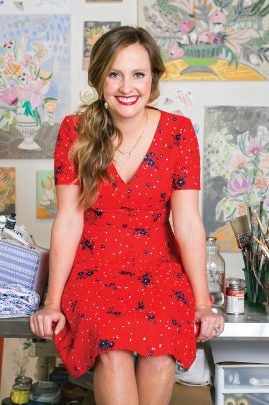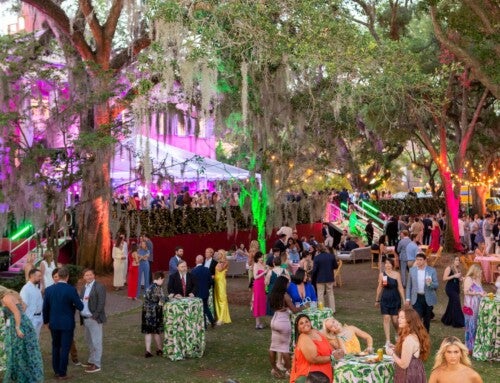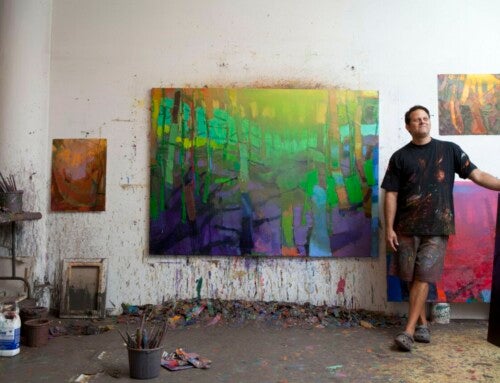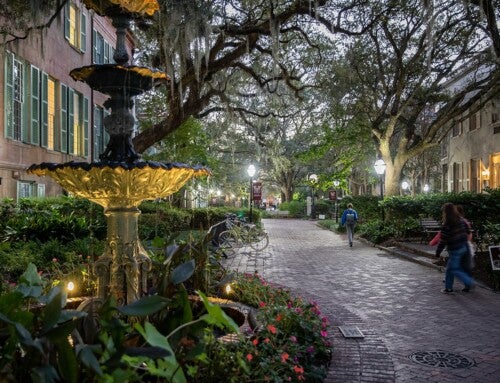 Some art belongs in museums. Some is best hung in galleries. Some art, though, isn’t so limited. Some art can go just about anywhere. And, with her bright color palette, her penchant for pattern and her eye for opportunity, Lulie Martin Wallace ’09 can go anywhere she wants.
Some art belongs in museums. Some is best hung in galleries. Some art, though, isn’t so limited. Some art can go just about anywhere. And, with her bright color palette, her penchant for pattern and her eye for opportunity, Lulie Martin Wallace ’09 can go anywhere she wants.
by Alicia Lutz ’98
photography: Diana Deaver
makeup: Kelly Thorn Campbell
stylist: Rossana Russo
Lulie Martin Wallace ’09 doesn’t look like an artist. At least not the way artists have been painted for us in our culture: disheveled, a little “out there,” reluctant to play by society’s rules. The artist we usually imagine is unconventional, eccentric, maybe a little bit of a rebel.
The put-together, down-to-earth Georgia girl in front of us, however, is polished, aware of her audience and glad to please that clientele. She laughs freely, is easy to talk to and looks like she might be more at home at a garden party than an art studio.
The bright colors and feminine florals lining the walls in her studio on Charleston’s St. Philip Street, however, burst that impression. At once, the paintings show her comfortable artistic talent and her light, playful aesthetic. You can see that she is at home here, that she belongs here in the studio, creating works that will brighten up any room in any home. You can see, too, why the studio can’t contain her – why her art has a wide market, why she can’t be boxed in or pinned down.
It’s also clear why, so early in her career, Wallace is already all over the place: on the pages of Southern Living, HGTV Magazine, Better Homes and Gardens, Coastal Living; on bags, lunchboxes, fabrics, calendars, bedding; in Urban Outfitters showrooms and Anthropologie catalogs; in closets, powder rooms, guestrooms and garden sheds across the country.
No, Lulie Martin Wallace is no starving artist. Instead, she has managed to transform her art into a business that can take her just about anywhere.
 A Self-Portrait
A Self-Portrait
“Friendly, joyful, bright, quick, thoughtful, eclectic and not afraid of the dark.”
Beaming, Wallace looks up from her iPhone, where she keeps the list of words that describe her personal aesthetic. “That’s it! That’s me!”
It’s exactly what you see in her art, too.
“My art reflects who I am – I’m bright, talkative, easygoing, and my art is an extension of my personality. So when I describe it, I’m just describing part of myself,” says Wallace. “I tend to create bright, joyful work, because that’s how I see the world. It’s eclectic, because that’s how I am, too: kind of all over the place, not locked into one thing.”
When Wallace came to the College of Charleston from Columbus, Ga., where she’d spent her childhood doing arts and crafts (making stationery from cut-up construction paper, for example), she thought she wanted to go into either social work or graphic design. Not quite ready to commit to either field, however, Wallace opted to delay that decision until it was time to apply to graduate school. For now, she decided, she would major in studio art and minor in Spanish. She wanted to leave things open.
“I’ve always said I wanted six lives to do six different things with my life,” Wallace laughs. “The main things I wanted to do were design and counseling. I like psychiatry, I like people, I like how the mind works. But I’d also love to be involved in the restaurant world. I’d love to have a bed and breakfast. And I’d love something that involves interesting travel, but not too much travel!”
Wallace explored her interests in both social work and travel when, the summer after her junior year in college, she interned at an international adoption agency in Spain. As much as she enjoyed it, however, she stuck with her studio art major when she returned to campus.
“All my teachers at the College were incredibly helpful and inspiring. They wanted us to do our best, and that made you want to work harder,” says Wallace, noting that studio art professor Cliff Peacock left a particularly lasting impression on her and her artwork. “He was very influential in my color palette. Still now, there are colors I use that, every time I put them on the canvas, I’m like, ‘Cliff Peacock!’
“My professors were my favorite thing about the College,” Wallace continues. “I think the encouragement they gave me was the most important thing to my career. They really think you can do it.”
Wallace, however, still needed further convincing.
“I wasn’t really confident in my painting until the second semester of my senior year,” she says. “When I started painting something that I would put up on my own wall, that’s when I got excited about it.”
Once she was creating something that belonged not just in a studio, but in a home – that’s when Wallace discovered confidence in her own personal aesthetic. And, when friends said that they, too, wanted to hang her paintings in their homes, her confidence bloomed.
Just by being true to herself and what she was attracted to, she’d found her artistic voice.
“My inspiration comes from all over the place – from all the things I’m attracted to: other artists, other brands. I create the kind of things that I want to have – the kind of things that I, myself, am obsessed with,” says Wallace, adding that she sees herself in everything she does. “What inspires you is what inspires your art, so there’s some side of you in everything you create. If you’re an artist, everything you make is a self-portrait.”
It’s easy to see Wallace in her fresh, happy, vibrant paintings. There’s a sense of freedom, of exploration. You can almost feel the fun she’s having with color, shape and composition in her signature floral still-life paintings.
It was with her paintings of flowers that Wallace really came into her own. The stylized blossoms contrasted by unexpected stripes and abstract geometrics are all hers. She’d created her very own aesthetic, her very own brand.
And she ran with it.
 She began painting bridal bouquets on commission, and – to expand her floral repertoire and get further inspiration – she struck up relationships with florists producing innovative arrangements.
She began painting bridal bouquets on commission, and – to expand her floral repertoire and get further inspiration – she struck up relationships with florists producing innovative arrangements.
“Most of them are out of Brooklyn – and they’re all consistent with my aesthetic. The type of person who is going to like my painting is going to be the same type of person who is as obsessed with their flowers as I am,” says Wallace.
And if bold bouquets are Wallace’s obsession, color combinations are her passion.
“My first love is color. I love bright and fun colors. I love to see how colors work together, bounce off of each other – it is so fun,” she gushes, adding: “I feel like my color palette is definitely recognizable throughout everything I do – it’s a big part of my brand.”
The Lulie Wallace brand is certainly distinctive: A work by Lulie Wallace is unmistakably by Lulie Wallace.
“My brand is something that I’m very careful about. I have to rein it in sometimes, because I tend to be all over the place,” says Wallace. “Ultimately, my brand represents the type of people who purchase my artwork, people like me.”
In other words: approachable, happy, bright people who enjoy a little color in their lives.
The Business of Art
Rare is the artist who manages to translate creative sensibility into business savvy, to turn talent into profit, transform hobby into career.
But Wallace chose to give it a shot. She started with what she knew: herself. And she went where she would go to buy art: online.
“Marketing my art through social art outlets made more sense to me than going through galleries,” says Wallace. “First, I don’t think my flowers are the best fit for the walls of a traditional gallery; they’re meant to be in people’s homes to enjoy. Second, most local galleries have souvenir art – things that appeal to people visiting Charleston, walking down the street, stopping into the gallery. The person who is going to be interested in your art has to happen to be in that gallery and in the market to buy. My buyer is limitless because anyone has access to a computer.”
Still – even though she knew in her gut that, online, she was everywhere she needed to be – when a coffee shop approached her about displaying some of her work, the added exposure was tempting.
“Lulie, when have you ever been in a coffee shop and said, ‘I’m going to buy that $400 painting?’ It’s devaluing to what you do,” warned a more experienced artist at Redux Contemporary Art Center, where Wallace had just begun renting out a studio space.
“That was one big thing for me: recognizing what avenues promote your art well, and what avenues devalue it,” Wallace says, adding that Redux – a nonprofit organization founded in 2002 by Bob Snead ’02 – has been influential in her growth both as an artist and as a business owner.
“It’s a great environment to learn how to promote yourself,” she says, naming Sally Benedict ’07, for one, as being a great help to her. “A couple of people really took me under their wings and said, ‘If you want your art perceived in a certain way, you should head into this direction, and avoid going in this direction.’
“The route I’ve gone – growing my business through social media rather than the traditional way of being represented by a gallery first – I think has given me an advantage,” Wallace continues.
 It certainly didn’t hurt: Within just a year of being promoted on social media, her art caught the attention of some of the heavyweight design blogs – most notably Grace Bonney’s highly influential Design*Sponge.
It certainly didn’t hurt: Within just a year of being promoted on social media, her art caught the attention of some of the heavyweight design blogs – most notably Grace Bonney’s highly influential Design*Sponge.
“Back then, the main form of important press you could get as an artist was being featured on a blog,” says Wallace. “And if you wanted to be paid attention to, you had to be on the right blogs.”
Wallace ended up all over all the right blogs – and popular national retailers took note: Urban Outfitters offering to sell two of her original paintings as large-scale wall posters and Anthropologie offering to buy a selection of her original works to use in its House & Home department.
Since then, Wallace has been featured in a number of national magazines, including Flower, Matchbook, Coastal Living and Cottage Living, and her art has appeared in Southern Living, HGTV Magazine and Better Homes and Gardens. Her works have also been featured on Anthropologie’s Mistral soap collection packaging, Witherbee bedding collection, as well as on seed packages, calendars, framed prints and more.
“It’s very awesome – such an encouragement to keep going. Really and truly, it raises the ceiling. It’s like, ‘OK, if this is where you want to stay, then there’s a lot more work to be done,’” says Wallace, who continues to collaborate with Anthropologie and Urban Outfitters, as well as One Kings Lane and Serena & Lily. “It kind of puts a little fire under your belt that says, ‘Hey, what’s next?’ It just makes you want to keep working in that kind of realm. It really opened up my eyes to this whole other side of the business. It made me think, ‘OK, where else can we put art?’”
The answer, it turns out, is pretty much all over the place.
There’s a Pattern Here
There is no limit to what art can be, where it can go or what it can do. It’s not relegated to a spot on the wall or behind a frame on the table. It can function as more than just a pretty picture – more than just something to be admired.
So, when Wallace saw her art come down off the walls and transform into entirely different products – pillows, bedding, scarves and bags – she knew the possibilities were endless.
“It’s super exciting when my art comes off the canvas and takes on a totally different art form. I absolutely love seeing my artwork transform like that,” says Wallace, who keeps a close eye on a number of different interior brands she’s interested in working with – keeping up with what represents their brand best, what trends they’re attracted to and what other artists’ works they are using. “A lot of other artists they collaborate with are doing pattern-based designs. They just take your art and turn it into patterns – and patterns can go anywhere.”
Thus, Wallace’s newest obsession.
 “I love making patterns. It gives you the opportunity to turn your art into something completely different,” she says, explaining the process of surface design, in which she first paints little motifs, most of them floral, and then scans them to combine them in various arrangements, creating patterns. “You can look at it in all different directions. There are limitless possibilities to combining them. There are 100 different things to do with just a little something.”
“I love making patterns. It gives you the opportunity to turn your art into something completely different,” she says, explaining the process of surface design, in which she first paints little motifs, most of them floral, and then scans them to combine them in various arrangements, creating patterns. “You can look at it in all different directions. There are limitless possibilities to combining them. There are 100 different things to do with just a little something.”
In addition to pitching her patterns to other brands, Wallace has been making her own products: stationery, bags, scarves, lunchboxes and textiles.
“The more I explore pattern design and the more I dig through the portfolio for licensing opportunities, the more I want to get my own fabrics out there – see whose hands I can get into. I just think fabrics are just a very super-fun way of putting my patterns out there myself. It’s easy to source and it’s easy to promote,” says Wallace, who has learned a lot not just about sourcing over the past year or so, but also about production and licensing. “It’s such an interesting learning opportunity, to dive into something totally different.”
Although she’s currently dedicating a big chunk of her time to creating her own fabrics, Wallace relies on her painting sales to carry the business – which often means working on 15 paintings at a time.
“I’d like to be able to focus a little better and not be so all over the place. Pattern design really lets me slow down and focus on one thing, because each motif is its own entity,” she says. “I love the idea of the textile and fabric design taking off. Then my patterns could cover just about anything – upholstery, clothing, you name it. That would be huge.”
It seems the likely trajectory – after all, there’s a definite pattern of transformation and growth in Wallace’s career. In the six years since she graduated from the College – she’s gone from finding her artistic voice to making a name for herself in the design world, to designing, sourcing and producing her own products.
“I started small, and my business slowly grew, so I feel like I’ve learned a lot within the past six years,” says Wallace, who now has a part-time assistant to help with administrative tasks as well as some of the graphic design that goes into pattern making. “I feel like my business sense has really just developed over time, on an as-needed basis. It wasn’t something that came naturally to me, but, little by little, I’ve just grown my business sense.”
Even in those first few months in her studio at Redux – where she now serves on the board of directors – she could have never imagined where she’d be today. The career she’s built for herself has been completely unexpected every step of the way.
“When I was in college, I never even knew the job I have now existed,” says Wallace, who is proud to have two CofC arts management students interning with her every semester. “I just know that I appreciated encouragement when I was in school, and I just feel like it’s a neat and important thing to do for other people. I really appreciate my interns’ help – it’s instrumental in what I do. A lot of what they do is help me pack up and ship out my products. But I want to be sure they’re getting a lot out of it, too, so I make sure to ask them about their goals and how I can help them. It means a lot to me to bring other people in and share my experience and encourage them, too.”
And – as the very portrait of a successful artist-turned-businesswoman – Wallace has the perfect pattern to study. She proves that artists can’t always be pigeonholed: They belong wherever their craft takes them.
“The thing that makes me excited about what I do is how it’s evolved. I’m learning something all the time. I think people stay interested, too, because it’s kind of like, ‘Well, what’s she doing now?’” says Wallace. “Because I have no idea what I’ll be doing in three years. I don’t know where what I’m doing now will take me.”
All we can be sure of: There are no limits to where she can go.




